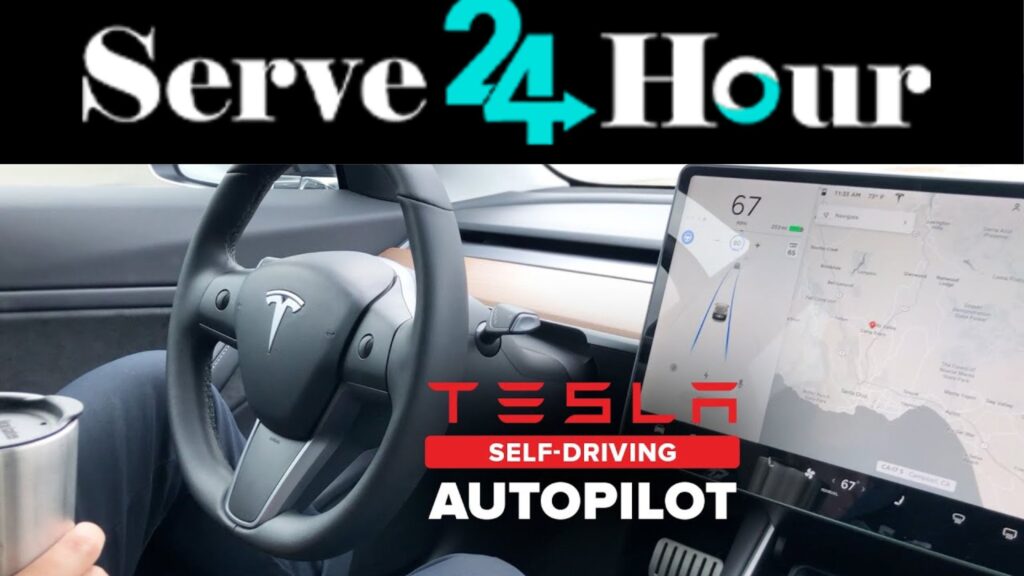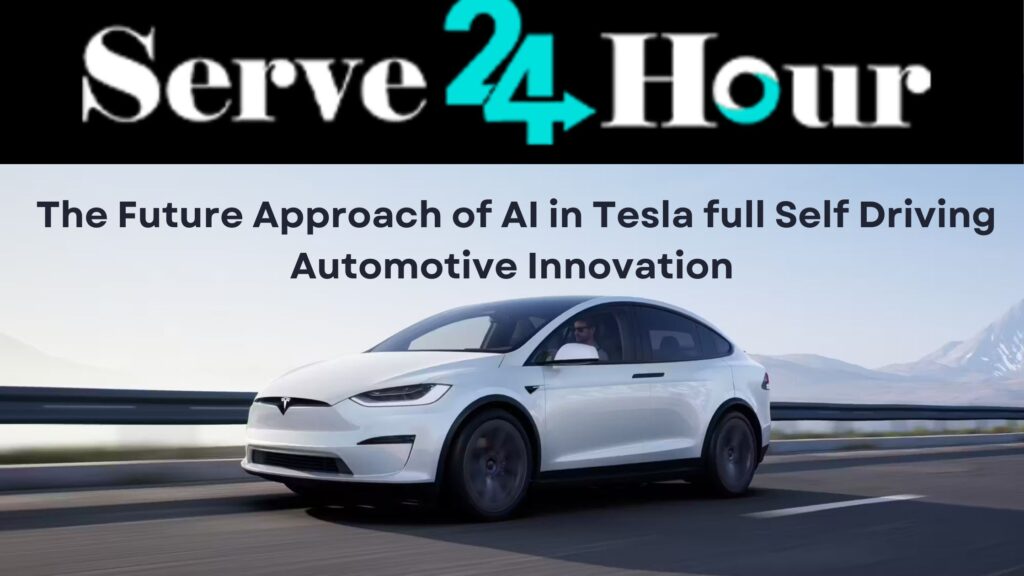The Future Approach of AI in Tesla full Self Driving Automotive Innovation
Tesla’s DNA has always been centered around intelligence. Their innovative work in the area of self-driving cars is especially indicative of this. By using artificial intelligence (AI) to produce totally autonomous vehicles, Tesla has transformed the automotive industry with its unwavering pursuit of innovation.
Tesla’s advanced artificial intelligence system lies at the core of their self-driving technology. Tesla’s artificial intelligence (AI) gives their cars the capacity to see, comprehend, and navigate their surroundings thanks to sophisticated machine learning algorithms. This sophisticated technology creates a complete real-time image of the vehicle’s surroundings by integrating data from a wide range of sensors, such as cameras, radars, and ultrasonic sensors.

The Advent and Evolution of Autonomous Cars
The road to completely autonomous vehicles began in the 1920s and has been a long one. This objective has been pursued by numerous manufacturers, with notable progress made over time. Waymo was the first business to provide self-driving taxi rides to the general public, and Honda was the first to market an SAE Level 3 vehicle—a vehicle that, in some circumstances, is capable of handling all aspects of driving but still needs a human driver to step in when necessary.
Not all manufacturers, though, have taken the same course. A number of companies have lowered their goals for autonomous vehicles in recent years, highlighting the difficulties and complexities involved in reaching complete autonomy in automotive technology.
WHAT IS TESLA ARTIFICIAL INTELLIGENCE?
With an emphasis on AI-based vehicle control, Tesla is nearing the last component of its FSD technology, guided by Elon Musk. The company wants to almost 100-fold reduce the complexity of the vehicle management code, which might significantly increase efficiency and dependability. Tesla’s development is encouraging, despite the high computing needs of training these complex AI systems.
Tesla achieved a noteworthy milestone by surpassing 150 million miles driven with FSD technology. This accomplishment demonstrates the abundance of training data gathered from actual driving situations, which is essential for improving the technology. It is anticipated that Tesla’s advancements in FSD technology will have a revolutionary effect on the electric car market, given its dedication to safety, innovation, and sustainable transportation.Artificial intelligence (AI) is a key component in improving the capabilities of self-driving cars. Leading electric car maker Tesla has been in the forefront of creating cutting-edge artificial intelligence (AI) technology to power its self-driving vehicles.
Tesla’s AI processes and analyzes enormous volumes of data from sensors, cameras, and radar systems using a combination of machine learning, deep learning, and neural networks. This allows the vehicle to precisely manage challenging road conditions and make judgments in real time.

Tesla’s Approach to AI in Self-Driving Technology:
Tesla’s approach to self-driving technology heavily relies on AI and machine learning algorithms. Through the collection of vast amounts of real-world data from its fleet of vehicles equipped with sensors and cameras, Tesla continuously trains its AI models to improve performance and safety. This approach, known as fleet learning, allows Tesla to leverage the collective driving experience of its vehicles to iteratively enhance its self-driving capabilities.
The Future Evolution of Tesla’s AI in Self-Driving Technology:
Looking ahead, the future evolution of AI in Tesla’s self-driving automotive innovation is poised to bring about significant advancements in several key areas:
- Enhanced Perception and Decision-Making: Tesla will continue to refine its AI algorithms to improve the perception of the vehicle’s surroundings and enhance decision-making capabilities. This includes better detection and classification of objects, understanding complex traffic scenarios, and predicting the behavior of other road users.
- Real-Time Adaptation and Learning: Future iterations of Tesla’s AI will focus on real-time adaptation and learning. This means the system will become more adept at dynamically adjusting to changing road conditions, unexpected obstacles, and diverse driving environments. Through continuous learning from new data, Tesla’s self-driving technology will become increasingly robust and versatile.
- Multi-Modal Sensor Fusion: Tesla’s future AI systems will leverage multi-modal sensor fusion to integrate data from various sources, including cameras, radar, LiDAR, and ultrasonic sensors. By combining information from different sensor modalities, Tesla can enhance the accuracy and reliability of its perception capabilities, even in challenging weather conditions or low-visibility scenarios.
- Edge Computing and Onboard Processing: To achieve real-time responsiveness and reduce reliance on external data processing, Tesla may employ edge computing and onboard processing capabilities. By harnessing the computational power of onboard hardware, Tesla’s AI systems can analyze sensor data and execute driving decisions with minimal latency, enhancing overall system performance and safety.
- Continual Regulatory Compliance and Safety Assurance: As autonomous driving technology advances, ensuring regulatory compliance and safety standards will remain paramount. Tesla will need to develop AI systems that not only excel in driving performance but also adhere to evolving legal and ethical frameworks governing autonomous vehicles. This may involve implementing robust safety mechanisms, conducting rigorous testing and validation, and fostering collaboration with regulatory bodies and industry stakeholders.
Challenges and Considerations:
Within the next five years, FSD technology will be fully developed, according to Tesla board member Kimbal Musk. This timeline portends a future in which steering-wheel-less cars might be sold, ushering in a new era of personal mobility.
The FSD system is trained using video footage from 5.5 million cars and employs ‘Shadow mode’ to learn from drivers. This method is quickening the development of Tesla’s FSD technology, in conjunction with over-the-air updates that improve the vehicle’s functionality and performance.
Though there is excitement about these developments, there are also misunderstandings regarding the timetable and privacy issues. Addressing these problems and promoting these changes is crucial as we move closer to a world with autonomous vehicles.
Despite the promising trajectory of AI in Tesla’s self-driving automotive innovation, several challenges and considerations must be addressed:
- Ethical and Legal Implications: The deployment of AI-driven autonomous vehicles raises complex ethical and legal questions, including liability, accountability, and privacy concerns. Tesla must navigate these issues responsibly and transparently to earn public trust and regulatory approval.
- Cybersecurity and Resilience: Autonomous vehicles are vulnerable to cybersecurity threats, such as hacking and malicious attacks. Tesla must prioritize cybersecurity measures to safeguard its AI systems and ensure the integrity and reliability of self-driving technology.
- Human-Machine Interaction: As self-driving technology becomes more prevalent, the interaction between humans and autonomous vehicles will evolve. Tesla must design intuitive user interfaces and communication mechanisms to facilitate seamless collaboration between drivers and AI systems, promoting trust and safety on the road.
- Global Adoption and Localization: Tesla’s AI-driven self-driving technology must be adaptable to diverse geographic regions, road infrastructures, and cultural contexts. Localization efforts will be crucial to ensure optimal performance and user experience worldwide.
Conclusion:
In conclusion, the future approach of AI in Tesla’s self-driving automotive innovation holds immense promise for transforming the future of transportation. By advancing AI algorithms, leveraging real-world data, and addressing key challenges, Tesla aims to redefine the driving experience with safer, more efficient, and more accessible autonomous vehicles. As Tesla continues to push the boundaries of innovation, the evolution of AI in self-driving technology will play a central role in shaping the future of mobility.
